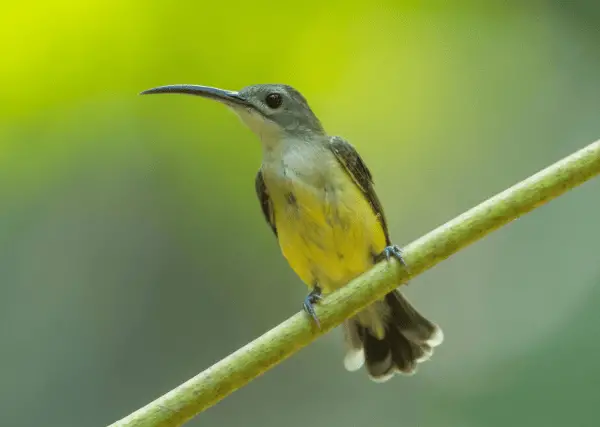It is not unusual for birds to have oversized body parts. If you're an avid birder, you would've probably noticed that some of those tiny chirpers have quite long beaks for their size.
Encountering small birds with long beaks is not as uncommon as you might assume. And we're not talking about one or two species - the diversity and uniqueness of these birds are unmatched. Let's explore some of these examples together.
14 Examples of Small Birds with Long Beaks
We have selected 14 examples of small birds with long beaks for you. Let's explore their characteristics and how they use their long beaks:
1. Brown-headed Nuthatch (Sitta pusilla)
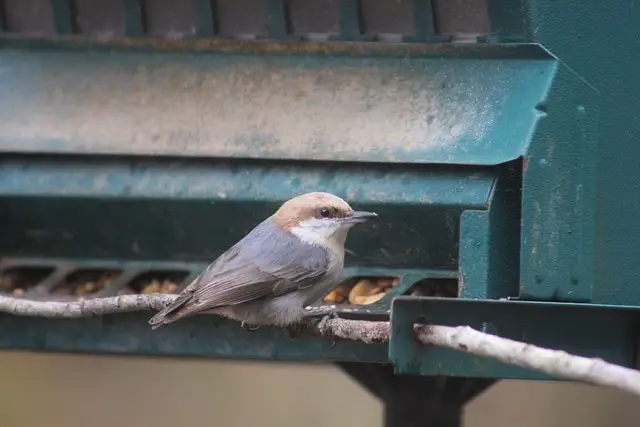
We start with the Brown-headed Nuthatch. This is a small songbird measuring around 4.5 inches in length. It has a brown head and a blue-gray back. Though it doesn't have a "long beak" per se, it is oversized compared to its tiny body.
Its beak is perfectly suited for its foraging and hunting habits.
These nuthatches are found primarily in pine forests of the southeastern United States. They use their beak to pry open bark and access insects hidden within tree crevices. Its long beak allows it to extract insects such as beetles, ants, and spiders with precision.
2. Sword-Billed Hummingbird (Ensifera ensifera)

The Sword-Billed Hummingbird is a medium-sized hummingbird with a body length of approximately 5.5 inches. Its most striking feature is its exceptionally long beak, measuring up to 4 inches.
The thin beak is just an inch and a half shy of its total length!
This small bird species is found in high-altitude cloud forests of the Andes Mountains in South America. The Sword-Billed Hummingbird's long beak is perfectly adapted for accessing nectar from long tubular flowers.
This small bird species can reach the nectar by inserting its long beak deep into the flower while hovering in mid-air. Why do they do so mid-air, you may ask? Well, the Sword-Billed Hummingbird's bill is too long to allow it to land on the flower.
3. Rufous-tailed Jacamars (Galbula ruficauda)
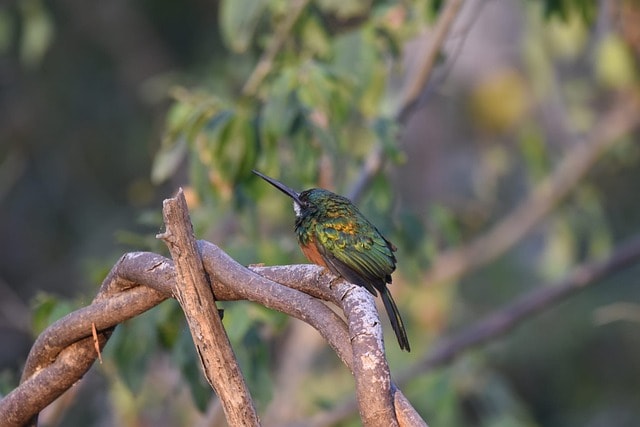
Rufous-tailed Jacamars are small birds with a length of around 7 inches. They have a long, slender beak that is slightly curved. They are colorful birds with iridescent green plumage and a distinctive rufous (reddish-brown) tail.
This small bird species is native to Central and South America, particularly tropical rainforests.
Rufous-tailed Jacamars are active predators and use their beaks for this purpose.
Rufous-tailed Jacamars use their bill to catch insects in mid-air with swift and precise movements. Their long beaks allow them to snatch flying insects like bees, wasps, and dragonflies out of the air.
4. Common Snipe (Gallinago gallinago)
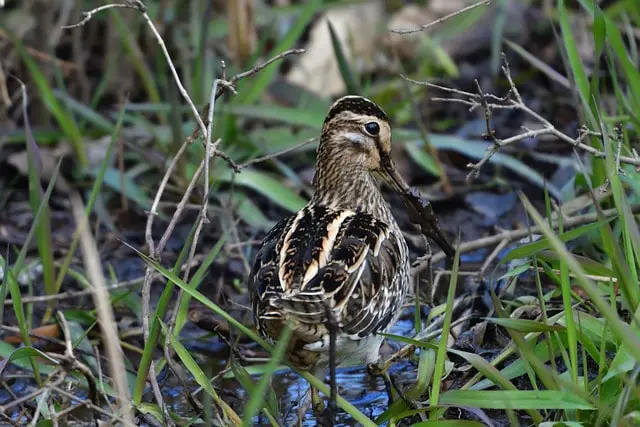
The Common Snipe, scientifically known as Gallinago gallinago, is a wading bird found in wetland habitats across Europe, Asia, and parts of North America. It has a length of about 25-28 centimeters (10-11 inches).
The Common Snipe uses its long bill to probe into soft mud to hunt.
It uses its long beak hunts for invertebrates like worms, insects, and small crustaceans. Its bill is relatively long and slender, allowing it to reach deep into the soil or mud to capture its prey. The sensitive tip of the bill helps detect movements of prey beneath the surface.
This bird is also known for its camouflaged plumage, which provides excellent camouflage in its wetland habitat. It has a mottled brown coloration on its back and streaked underparts, allowing it to blend into the surrounding vegetation.
5. Sedge Wren (Cistothorus platensis)
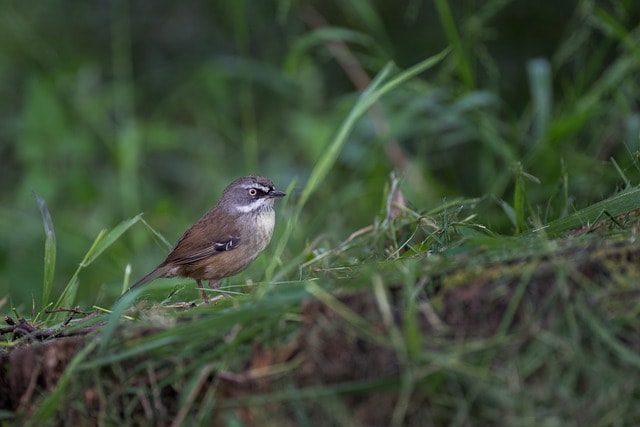
Sedge Wrens are small wrens measuring around 4.5 inches in length. They have a sharp beak that may not appear as big in general but is bigger in proportion to the bird's body. These wrens are streaked and have brownish and buffy underparts.
They are primarily found in wetland areas such as marshes and meadows.
These wrens use their beak to probe marsh vegetation for insects, small invertebrates, and seeds. They peck and probe among grasses and reeds, using their bill to find prey.
6. European Bee-eater (Merops apiaster)
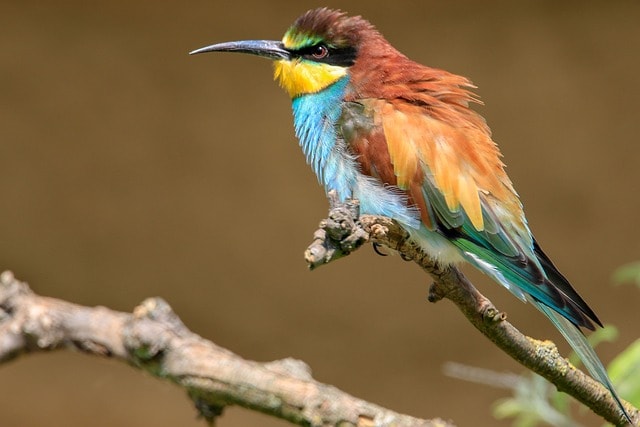
The European Bee-eater, scientifically known as Merops apiaster, is a stunning and colorful bird found throughout Europe, North Africa, and parts of Asia.
It measures about 10.5-11.5 inches in length.
European Bee-eaters are known for their vibrant plumage, featuring a combination of blue, yellow, orange, and green feathers. They have a slender body, long wings, and a distinctive downward-curved, elongated bill. They primarily feed on bees and other flying insects.
They perch on branches or wires, watching for insects in flight. When they spot their prey, they swoop down and catch it in mid-air using their sharp beak. After catching their prey, they return to their perch and beat the insect against the branch to remove the stinger before consuming it.
7. Winter Wren (Troglodytes hiemalis)
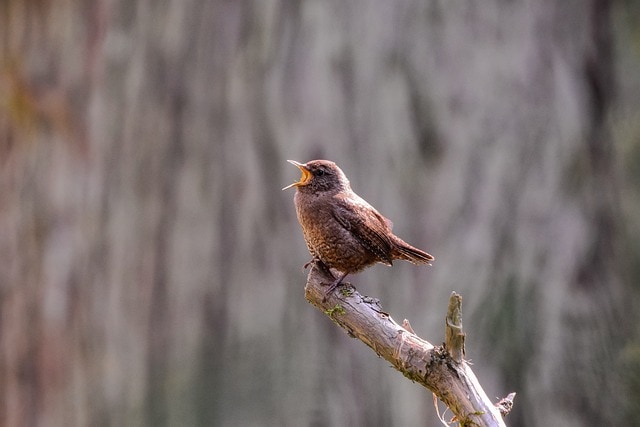
Winter Wrens are little birds with slender beaks (like the Marsh wren and House wren) and a body length of about 4.5 inches. These wrens are round-bodied with dark brown plumage and have a distinctive song.
They are found in dense forests and woodlands of North America and Europe.
Their slender bill allows them to reach into tight spaces to extract prey.
Winter Wrens use their beak to search for insects, spiders, and other small invertebrates in leaf litter, fallen logs, and dense vegetation.
8. Carolina Wren (Thryothorus ludovicianus)
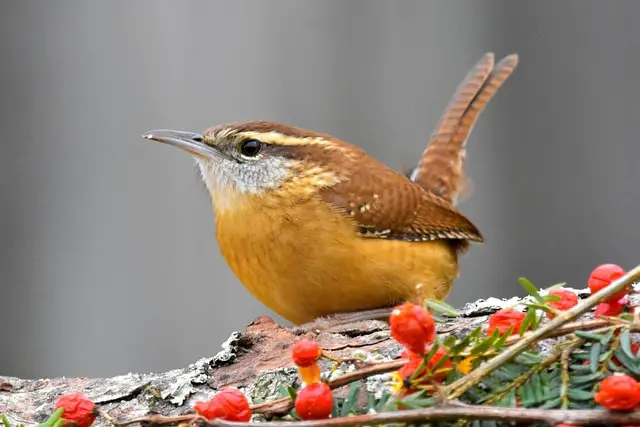
Carolina wrens are medium-sized wrens with a slightly curved beak, measuring around 5.5 inches in length. Their rusty-brown back, buff-colored underparts, and bold white eyebrow stripe stand out even from a distance if you've got a keen eye.
Carolina wrens probe crevices with their curved beak.
They are common in the eastern and southeastern United States, inhabiting woodlands, thickets, and suburban areas. Carolina Wren birds use their beak to search for insects, spiders, and small fruits in leaf litter, tree bark, and crevices. Their bill allows them to efficiently extract prey and probe various hiding spots.
9. Long-Billed Hermit (Phaethornis longirostris)
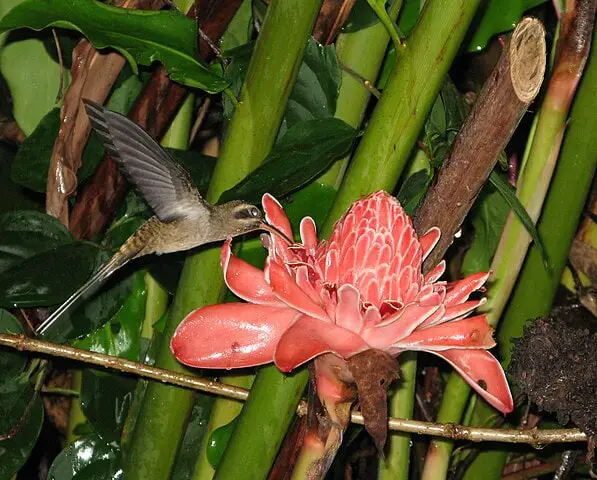
The Long-Billed Hermit, scientifically known as Phaethornis longirostris, is a small hummingbird species found in Central and South America. It is known for its distinctively long, curved bill, which gives it its name.
The Long-Billed Hermit is typically around 4-5 inches in length.
The bill itself can measure up to 2 inches, which is considerably long. This adaptation allows the bird to access the nectar of long, tubular flowers that are inaccessible to other hummingbirds with shorter bills.
They are often found in forested habitats, where they feed on nectar from a variety of flowering plants. These birds are important pollinators, as their long bills enable them to reach the nectar hidden deep within the flower. They also feed on small insects and spiders, which provide an additional source of nutrition.
Males have striking plumage, featuring green upperparts and a white underbelly with cinnamon-colored streaks. They also have a distinctive reddish-brown tail. Females, on the other hand, have duller plumage with more muted colors.
10. American Woodcock (Scolopax minor)
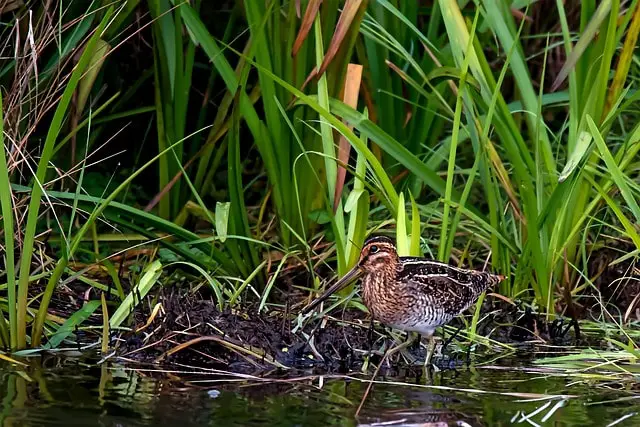
The American Woodcock is a medium-sized wading bird found in woodland habitats of eastern North America. Despite its somewhat unassuming appearance, it possesses fascinating adaptations for its unique feeding behavior. The American Woodcock has a plump body, relatively short legs, and a long, slender bill that is sensitive at the tip.
Its eyes are situated high on its head, allowing for a wide field of vision.
These birds are primarily active during the twilight hours. Feeding primarily on earthworms and other soil-dwelling invertebrates, the American Woodcock uses its long bill to probe the soil in search of prey. The bill is flexible and sensitive at the tip, allowing it to detect the movements of earthworms beneath the surface.
It then uses its bill to grasp and extract the prey from the ground.
American Woodcocks are well-camouflaged birds, with mottled brownish plumage that blends with their woodland surroundings. They rely on their camouflage and the "freeze" strategy to avoid detection by potential predators.
11. Red Crossbill (Loxia curvirostra)
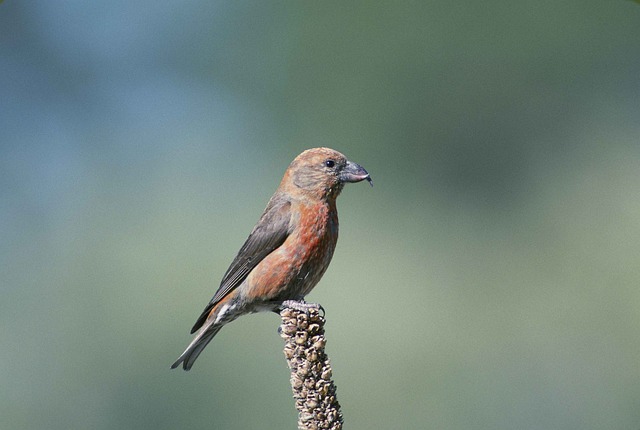
Red Crossbills are small finches with a unique crossed beak. Measuring about 6 inches in length, these finches have variable plumage colors. They are found in coniferous forests across North America, Europe, and Asia.
Red Crossbills have variable plumage colors.
The crossed tips of the Red Crossbill's beak allow it to pry open the scales of conifer cones and access the seeds within. Their specialized bill adaptation enables them to exploit a niche food source that other birds may find challenging to access.
12. Common Redshank (Tringa totanus)
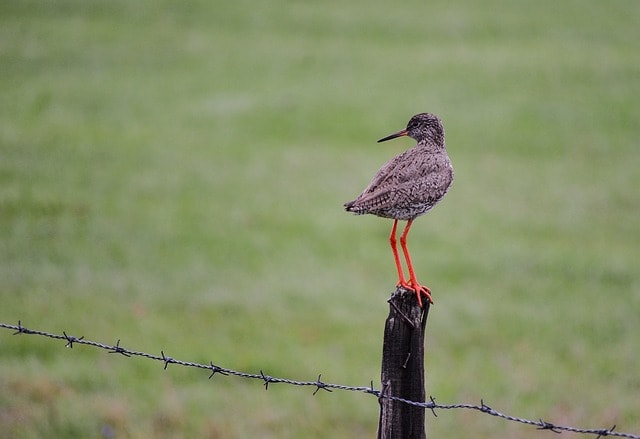
Common Redshanks are medium-sized wading birds. They have long, slender beaks and measure around 8 inches in length. These birds have mottled brownish plumage and long red legs. They are found in wetlands, marshes, and coastal areas across Europe and Asia.
These birds probe mud in marshes to hunt for crustaceans and other prey.
Common Redshanks use their beak to probe mud and shallow water to find invertebrates, small fish, and crustaceans. Their long bill allows them to reach deep into the substrate to capture prey items.
13. Brown Creeper (Certhia Americana)
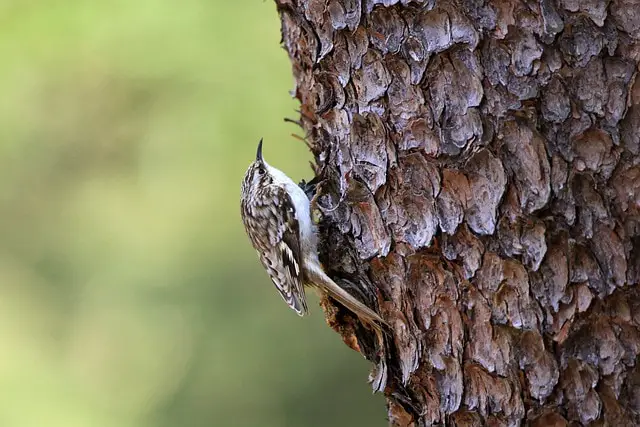
Brown creepers are small songbirds native to North America. With its mottled brown plumage and slender body, it is well-camouflaged against tree trunks. However, its most remarkable feature is its long, curved beak.
Brown creepers use their beaks for foraging.
Their foraging behavior involves spiraling up tree trunks in a helical pattern. As the bird ascends, it uses its beak to probe deep into the bark's crevices. This allows the Creeper to locate and capture insects, spiders, and their eggs hidden within the bark.
This unique feeding strategy and specialized beak adaptation give the Brown Creeper an advantage in accessing food resources that other birds may struggle to reach. The Brown Creeper's fascinating foraging behavior and beak adaptation make it a captivating species to observe in its woodland habitat.
14. Rufous Hummingbird (Selasphorus rufus)
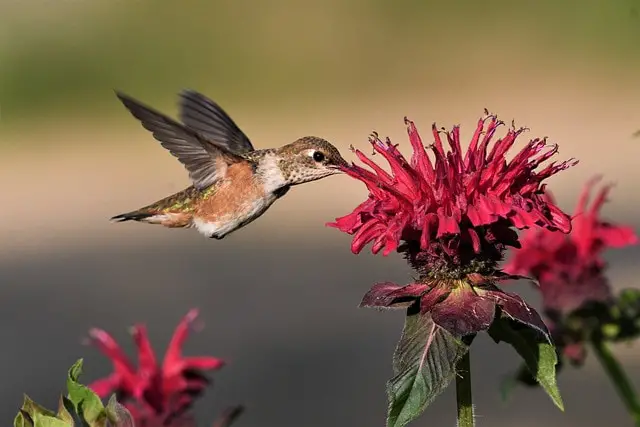
Rufous Hummingbird is a small bird species found primarily in North America. With its reddish-brown plumage and iridescent feathers, this bird is visually striking. This striking visual display makes them easily recognizable among other hummingbird species.
This small bird is commonly found in a variety of habitats, including forests, woodlands, and mountainous regions. They have a wide range that stretches from Alaska and western Canada down to Mexico and parts of the Gulf Coast.
If you have a hummingbird bath or a water fountain in your yard, you may be lucky enough to attract a charm!
They use their beaks to extract flower nectar and catch their prey.
One of the notable features of the Rufous Hummingbird is its long, slender beak. This specialized beak allows them to feed on nectar from tubular flowers. They also use their beaks to catch small insects and spiders as an additional source of nutrition.
Bottom Line: How To Spot These Magnificent Birds
Small birds with long beaks exemplify the wonders of nature's intricate design. Their specialized foraging techniques, beak adaptations, and conservation significance offer valuable lessons about adaptation and the need for biodiversity conservation.
To observe these birds in nature, start by researching their preferred habitats and then venture into those areas armed with binoculars and a field guide. Be patient and observant, listening for their distinctive calls and watching for their unique foraging behaviors.
Move slowly and quietly to avoid startling them, and try to blend into the surroundings by wearing neutral-colored clothing. Position yourself near trees, shrubs, or flower patches where these birds are likely to feed or rest. With time, patience, and a keen eye, you can witness the beauty and marvels of these small birds with their extraordinarily long beaks.
The sight will be worth it, for sure!
FAQs
What are some examples of small birds with long beaks?
Some examples of small birds with long beaks include the brown-headed nuthatch, sword-billed hummingbird, sedge warbler, brown creeper, Bewick's wren, and more.
What are some examples of small birds with curved beaks?
Some examples of small birds with curved beaks include the rufous-tailed jacamar, Carolina wren, canyon wren, and ruddy turnstone. These birds have curved beaks that they use to access specific food sources.
Why do small birds need big beaks?
Small birds (like sedge warbler, Carolina wren, etc.) need big beaks to suit their specific feeding habits. A big beak allows them to access fruits, seeds, insects, or nectar. It can also help them break open tough shells or extract insects from crevices.
